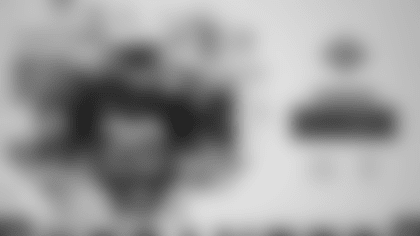Every team in the NFL does some things better than others. Some teams are particularly good at one thing, maybe even the best in the league. Think the New England Patriots and their play-action seam pass to the tight end. Or the Pittsburgh Steelers with the counter run. Or the Carolina Panthers' goal-line QB keeper.
None of these signature strengths are a secret. Opponents prepare for them in the film room and on the practice field, and yet these teams continue to succeed with the same concepts. That is, of course, often due to the presence of some especially skilled players, like Rob Gronkowski in New England, Le'Veon Bell in Pittsburgh and Cam Newton in Carolina. Still, these well-known plays generally require precise execution by many of the 11 players on the field. And when they work, they are often a thing of beauty, at least to football fans.
Each game week during Tampa Bay's 2018 regular season, we are going to look at a "Signature Play" that the Buccaneers upcoming opponent utilizes often and particularly well. With the help of images of a sample play at various points during its execution, we're going to try to understand why this play commonly works so well. This week, the Buccaneers' defense will try to contain one of the league's most consistently productive receivers, A.J. Green. Cincinnati's West Coast offense has many ways to get the ball to Green, but one of them is to put him in the middle of a 3x1 overload and let him beat press coverage.
CINCINNATI BENGALS' SIGNATURE PLAY: 3x1 A.J. GREEN INSIDE FADE
The Bengals drafted Georgia's A.J. Green fourth overall in 2011 and have surely never regretted that selection. Green has eclipsed the 1,000-yard mark every year except for 2016, when injuries caused him to miss six games…and he still averaged a career-best 96.4 yards per outing to nearly get to quadruple digits. If Green makes the Pro Bowl this year (he is going to make the Pro Bowl this year), it will mark the eighth time in eight NFL seasons he has done so.
Green's many assets include size (6-4, 210), wingspan, leaping ability, body control and incredible hands. He has elite ball skills and is one of the NFL's best at jump balls. The Bengals can and do move him all over the formation.
Today we're going to look at one specific setup for Green that works in part because fellow wideout Tyler Boyd has emerged as a legitimate second threat, something the team has been looking for since both Mohamed Sanu and Marvin Jones departed after the 2015 season. As we will detail below, this specific play can produce good results for the Bengals whether or not the opposing defense decides that Green is the primary problem.

The Bengals went to Atlanta in Week Four and got drawn into a shootout that included 902 combined yards, 73 points, 55 first downs and 18 third-down conversions. That's a lot of offense! Cincinnati eventually won, 37-36, on a 13-yard touchdown grab by, yes, A.J. Green with seven seconds left. But the Bengals also scored their first points, and evened the game at 7-7 after Atlanta took the game's first possession down the field for a touchdown, on a Tyler Eifert catch set up by Green's biggest play of the day.
As the scoreboard shows, the Bengals were facing a third-and-seven at their own 36, the result of a false start penalty against right tackle Bobby Hart. They responded by spreading things out in a 3x1 formation that let quarterback Andy Dalton choose between his two favorite targets.

This is called a three by one setup because the Bengals have three receivers split out to the right and one – actually a tight end, Tyler Eifert – alone on the left. As you can see in the image above, RB Giovani Bernard starts the play lined up outside Eifert to the left. This is a common tactic to confirm that the opposition is playing man-to-man defense; the 3x1 formation is also useful in this regard as it brings all the cornerbacks over to the same side. Bernard is going to motion back into the backfield before the snap, setting up just to Dalton's left.
From the top, we have wide receiver John Ross out wide to the right. Green is next in the middle of the trips right, and Boyd is closest to the right tackle. Isaiah Oliver is on Ross and Robert Alford is on Green. In this particular game, top corner Marcus Trufant is playing in the slot due to the Falcons' injury situation. He is on Boyd. All three defensive backs are playing press coverage.
This is a "dime" defense for the Falcons, which means they have six defensive backs on the field. Cornerback Blidi Wreh-Wilson is the "dime;" he's on Eifert at the bottom of the screen. Brian Poole is a cornerback but in this case he's playing safety and is covering Bernard. Damontae Kazee is the single-high safety.


For Dalton, this is in effect a two-man route. Given the coverage that is presented, he is almost sure to throw to either Green or Boyd, and you can see in the first image that his head is immediately turned in that direction in his drop-back.
The Falcons have actually brought a bit of a blitz, as their four down linemen are being joined in pursuit of Dalton by linebacker De'Vondre Campbell, who lined up outside the left tackle. This ends up being a five-on-five pass-rush situation, and the Bengals' line holds up well enough for Dalton to get his throw off. Bernard stays in the backfield for a split second but here you can see him coming out into a route, where Poole is waiting. Bernard is probably Dalton's third option if neither Green nor Boyd get open. Ross, on the far right, runs a really short comeback route just for the purpose of keeping one more defender away from the play.
This ball is snapped at the Cincinnati 36. By the time Green has reached the 40-yard line, as you can see above, he has already pulled essentially even with Alford. At that point, Dalton is sure that Green is going to win his matchup and he has decided to throw the ball in that direction.

As this play unfolds, Kazee makes a curious choice in centerfield. His first move is a quick step to his right, away from Green. By the time he realizes where the ball is going, he is much too far away from Green and Alford to get back into the mix. In the above image, Kazee is just getting to the left hashmark and the ball is already well on its way to the receiver.
This route by Green is called a "fade" because he bends it towards the sideline to gain separation from the defender. With no safety help, that's enough to get him wide open down the right numbers.

And here is Green making the catch. It's an easy one for him because Alford hasn't been able to close the gap. Alford manages to push him out of bounds at the 26 after a gain of 38 but, as noted earlier, this drive ends up in a game-tying touchdown in an eventual Bengals win.
This was only Cincinnati's fourth play of the game. They would end up using this 3x1 formation three times, one with Green out alone to the left and Eifert in the middle of the trips. In the fourth quarter, on the game-winning drive, the Bengals converted a fourth-and-eight out of the same formation.


In this case, the Falcons saw this same formation and reacted differently. The defense is in a "two-man" look, with two safeties splitting the field deep and the other defensive backs in man-to-man coverage. This time, the cornerback on Green is playing well off, and on the snap he immediately shades out toward the sideline.
With that coverage and the safety leaning that way, Green is not a good option for Dalton. However, that leaves Boyd in man-to-man coverage and he wins at the top of his route, performing a sharp buttonhook to get just enough separation for Dalton to get him the ball. Boyd hauls it in for an 11-yard gain and a new first down, and the Bengals go on to win the game.


































